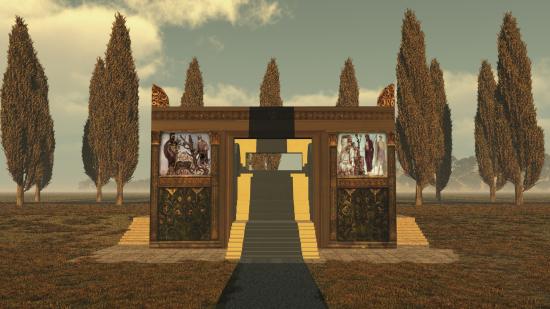3D models shed light on shadowy theory

A simulated view of the Ara Pacis (middle ground) and the Obelisk of Montecitorio (background) from the Via Flaminia in the Campus Martius. Image created by Matthew Brennan, Virtual World Heritage Laboratory, directed by Bernard Frischer. Copyright 2013 by Indiana University. All rights reserved.
Using NASA data and 3D modeling, Indiana University Bloomington professor Bernard Frischer and his research team have dispelled a long-held theoryregarding the relationship between two famous monuments in ancient Rome.
The Ara Pacis Augustae, or Altar of Augustan Peace, was built in 9 B.C.E. in ancient Rome’s Campus Martius. The marble altar stood as a propagandistic celebration of the peace and prosperity ushered into the new empire by Rome’s first emperor, Augustus. Near the Ara Pacis sat a 71-foot-high granite obelisk brought from Egypt by Augustus, which served as the gnomon, or pointer, of a meridian line. Following a 1976 theory proposed by German scholar Edmund Buchner, popular belief holds that the obelisk (now called the Obelisk of Montecitorio) was positioned to cast a shadow down the center of the altar on Augustus’s birthday on September 23.
Using survey and excavation data as well as historical sources, Frischer and his research team created a 3D model of the Ara Pacis and the obelisk—neither of which still sit in their original placement in Rome—as they were originally positioned in the 490-acre Campus Martius along the Via Flaminia, a major roadway in the ancient city. The researchers additionally used data from NASA’s Horizons System, a computation service that can provide information on the position of celestial objects at any point in history as seen from any point on earth. A simulation made by the Virtual World Heritage Laboratory, Indiana University and the IDIA Lab, Ball State University allowed the researchers to test whether or not Buchner’s theory held water—and it did not. The simulation demonstrates that on September 23 in 9 B.C.E., the shadow cast by the obelisk veered south on its approach to the altar and thus did not reach the center of the monument (see video below).
VIDEO = Test #1 of the Buchner Hypothesis about the Ara Pacis and Horologium of Augustus
http://vimeo.com/77600032
This video simulation tests the popular but outdated theory that the Egyptian obelisk—as part of a great sundial—cast a shadow down the center of the Ara Pacis on September 23, Augustus’s birthday. Video created by Bernard Frischer, Virtual World Heritage Laboratory. Copyright 2013 by Indiana University. All rights reserved.
In an interview with Bible History Daily, Frischer explains what the team further discovered:
On [certain] dates of the year—March 8, 9, 10, 11, 12, and October 6, 7, 8, 9, 10—when the sun’s disk is seen atop the obelisk by someone standing either on the Via Flaminia or on the access road from the Via Flaminia to the Ara Pacis, someone standing west of the Ara Pacis sees the shadow cast onto the façade [of the monument].

A person standing west of the Ara Pacis on a number of dates in 9 B.C.E. could see that the obelisk cast a shadow down the center of the Augustan altar. One of these dates is October 9, which was significant to Augustus.Image created by Matthew Brennan, Virtual World Heritage Laboratory, directed by Bernard Frischer. Copyright 2013 by Indiana University. All rights reserved.
While the obelisk did not cast a shadow down the middle of the altar on Augustus’s birthday, it did do so on a number of other dates. The researchers found that one of these dates—October 9—was the annual birthday festival of the Temple of Palatine Apollo, the temple Augustus built next to his home to honor his patron deity. That Apollo was important to Augustus is also known from inscriptions on the obelisk stating that the emperor dedicated the monument to the sun god.
Did the ancient Romans commemorate Apollo annually on October 9 at the Ara Pacis? “Perhaps there was a religious procession to see the sun atop the obelisk on October 9, but we don’t have evidence for that. This is merely speculation,” Frischer said.
As is the case with all disciplines concerning the ancient world, a great deal of evidence that could illuminate ancient cultures have not survived—or could never provide sufficient information taken alone. The work conducted by Frischer and his research associates, however, demonstrate how advanced technology can help us better understand enigmatic aspects of these cultures.
Brian Rose, James B. Pritchard Professor of Archaeology at the University of Pennsylvania, commented on Frischer’s innovative work in an email to Bible History Daily:
Prof. Frischer’s research has completely transformed the way that all of us will now teach thehorologium. His conclusions are not a complete surprise, since Apollo was Augustus’s patron deity, but no one suspected that his cult was so prominently linked to the Ara Pacis and the obelisk.
The simulations conducted by the researchers were independently confirmed by astrophysicist David Dearborn of Lawrence Livermore National Laboratory. Frischer and his colleague John Fillwalk, Director of the IDIA Lab, recently presented their findings at the Vatican’s Pontifical Archaeological Academy in Rome.
Read the press release from Indiana University Bloomington.